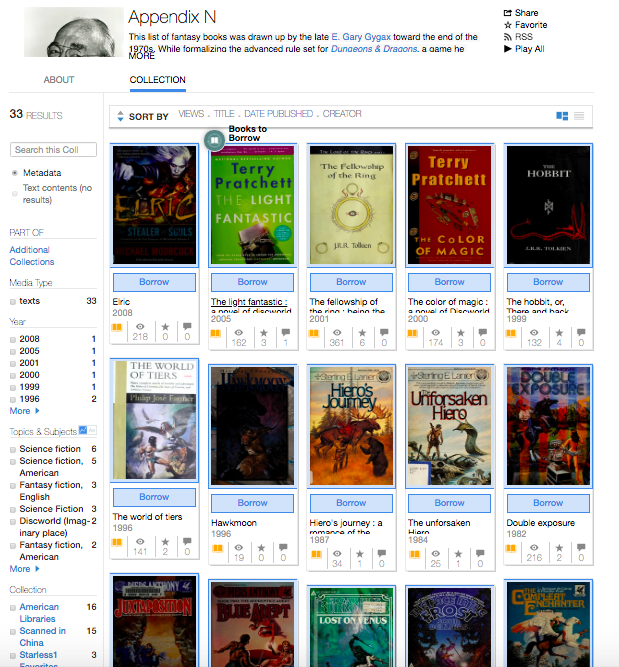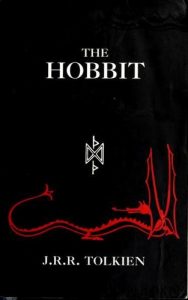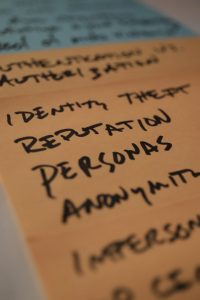By Jim Nelson

In a time when many of us are being asked to shelter in place and work from home, a hearty reading list can be invaluable. One intriguing list I recently rediscovered was drawn up by the late E. Gary Gygax toward the end of the 1970s. While formalizing the advanced rule set for Dungeons & Dragons, a game he created with Dave Arneson, Gygax added an appendix to his Dungeon Master’s Guide listing the books that inspired him to create his fantasy role-playing game. “Upon such a base I built my interest in fantasy,” Gygax wrote, “being an avid reader of all science fiction and fantasy literature since 1950.” Over the years this reading list has become so well-known in the role-playing world that it’s merely referred to as Appendix N. Now the Internet Archive has created an online collection of Gygax’s famous list.

If you’re unfamiliar with Dungeons & Dragons, it’s a role-playing game set in a universe of sorcerers, elves, dragons, and dank underground lairs. While D&D’s fantasy world might sound like J. R. R. Tolkien’s The Lord of the Rings, Gygax’s Appendix N shows he drew from a wide field of fantasy and science-fiction authors: R. E. Howard (creator of Conan), H. P. Lovecraft, Fritz Leiber (whom it’s believed coined the phrase “sword & sorcery”), Michael Moorcock, and yes, J. R. R. Tolkien. Some names on the list might surprise you, such as Leigh Brackett, whose screenwriting credits include the film noir The Big Sleep and John Wayne’s Rio Bravo. (Gygax probably included her for her planetary romances set on Mars, however.) Others would have faded into obscurity if not for Gygax’s list.
Forty years after it was published, Appendix N has taken on a life of its own within the role-playing community. Gygax’s list has been studied, dissected, and emulated. There’s even an Appendix N Book Club. Blogger James Maliszewski called Appendix N the “literary DNA” of D&D.

If you’re interested in expanding your diet of fantasy books, or you’re curious where the D&D phenomenon all started, you’re in luck. Internet Archive has many of the books on Gygax’s reading list available for borrowing. When Gygax was asked in 2007 if he would change any of the selections, he replied, “I wouldn’t change the list much, other than to add a couple of novels.” Internet Archive has a few of those later additions available as well. Happy reading!
Gygax’s original Appendix N list:

- Anderson, Poul: Three Hearts and Three Lions; The High Crusade; The Broken Sword
- Bellairs, John: The Face in the Frost
- Brackett, Leigh
- Brown, Fredric
- Burroughs, Edgar Rice: “Pellucidar” series; Mars series; Venus series
- Carter, Lin: “World’s End” series
- de Camp, L. Sprague: Lest Darkness Fall; The Fallible Fiend; et al
- de Camp & Pratt: “Harold Shea” series; The Carnelian Cube
- Derleth, August
- Dunsany, Lord
- Farmer, P. J.: “The World of the Tiers” series; et al

- Fox, Gardner: “Kothar” series; “Kyrik” series; et al
- Howard, R. E.: “Conan” series
- Lanier, Sterling: Hiero’s Journey
- Leiber, Fritz: “Fafhrd & Gray Mouser” series; et al
- Lovecraft, H. P.
- Merritt, A.: Creep, Shadow, Creep; Moon Pool; Dwellers in the Mirage; et al
- Moorcock, Michael: Stormbringer; Stealer of Souls; “Hawkmoon” series (esp. the first three books)
- Norton, Andre
- Offutt, Andrew J.: editor of Swords Against Darkness III
- Pratt, Fletcher: Blue Star; et al
- Saberhagen, Fred: Changeling Earth; et al

- St. Clair, Margaret: The Shadow People; Sign of the Labrys
- Tolkien, J. R. R.: The Hobbit; “Ring trilogy”
- Vance, Jack: The Eyes of the Overworld; The Dying Earth; et al
- Weinbaum, Stanley
- Wellman, Manley Wade
- Williamson, Jack
- Zelazny, Roger: Jack of Shadows; “Amber” series; et al
Gygax’s 2007 additions:
- Lanier, Sterling: The Unforsaken Hiero
- Anthony, Piers: Split Infinity series (Split Infinity, Blue Adept, Juxtaposition, et al.)
- Pratchett, Terry: Discworld series (The Colour of Magic, The Light Fantastic, et al.)


Jim Nelson is a science fiction reader & writer, in addition to being one of the Internet Archive’s core engineers. Prior to joining the Internet Archive, Jim was lead engineer and Executive Director of the Yorba Foundation, an open-source nonprofit. Jim also writes books and short fiction, including the dystopian novel “Bridge Daughter.” You can read more at j-nelson.net.
